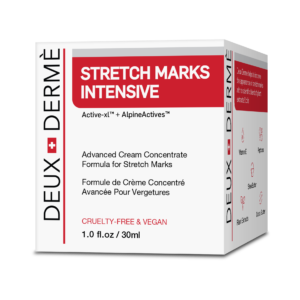If you’ve been thinking about having a baby or are currently expecting a child, you’re probably concerned about getting stretch marks. More than half of all women get stretch marks while pregnant, so your concerns are justified.
Stretch marks are red, pink, or purple lines that typically appear in the second trimester of pregnancy—between 13 and 21 weeks—but can develop at any time between conception and delivery. Women generally worry most about getting stretch marks on their bellies, but they can also develop on breasts, arms, thighs, and hips.
Stretch marks do not go away on their own, so for many women, getting stretch marks means a lifetime of trying to hide them from others.
What Causes Stretch Marks?
Stretch marks are caused when extreme changes in the shape of your body result in tearing of the lower layers of your skin. The rapidity with which your body grows and changes during pregnancy puts you at a high risk for developing stretch marks, but stretch marks are not exclusively caused by pregnancy. They also commonly appear on people when gaining or losing weight, on young children experiencing growth spurts, and on weightlifters when gaining muscle rapidly.
Skin is composed of multiple layers. The topmost layer of your skin—the layer you can touch and feel—is called the epidermis. Beneath the epidermis is the layer of skin known as the dermis. It is in the dermis where stretch marks form. Because the tearing that creates stretch marks occurs in the dermis, it does not bleed or scab like an external would, but the damage is visible in the form of stretch marks. Over time, the tears heal and form scars. This is why stretch marks appear initially as some hue of red but will fade and become white over time.
Symptoms of Stretch Marks
If you wait to feel symptoms of stretch marks before taking steps to prevent stretch mark development, it’s probably too late to do anything about it. Some people report itching prior to stretch marks appearing. Often, however, stretch marks appear with no symptoms at all.
How to Prevent Stretch Marks
The best way to live a life without stretch marks is to prevent them from ever appearing in the first place, and the best way to prevent stretch marks is to promote your skin’s elasticity. Soft, flexible skin should be less prone to tearing when stretched. There are multiple ways you can promote skin flexibility while pregnant that are perfectly safe for you and your baby:
- Avoid gaining excess weight: The common saying “eat for two” while you’re pregnant often feels like a free pass to eat as much as you want and gain as much weight as you want while pregnant. However, gaining excess weight that’s not directly related to the growing fetus in your uterus will increase your likelihood of developing stretch marks.
- Use a stretch mark prevention lotion: Applied all over your body twice a day over the course of your pregnancy, a stretch mark prevention lotion can encourage skin elasticity and help prevent stretch marks. Make sure, however, that the lotion or product you choose doesn’t contain chemicals that could be unsafe for use while pregnant. See the list below.
- Drink plenty of water: Drinking the recommended amount of water each day will keep your skin hydrated, and hydrated skin is less likely to tear.
- Eat foods to promote collagen production: Collagen is a protein in your body that promotes skin healing and elasticity. To promote collagen production, make sure your diet is rich in vitamin c (oranges, red peppers, cherries, and berries), green vegetables (brussel sprouts, broccoli, kale greens, and avocados), and low fat proteins (salmon, egg whites, tofu, and chicken).
- Avoid sunning and tanning: UV rays from sunlight and tanning destroy collagen in your skin and can make skin more brittle and likely to tear. For this reason, you’ll want to avoid sunning and tanning while pregnant. If you must spend time in the sun, make sure to wear sunblock.
Chemicals to Avoid in Stretch Mark Prevention Products
Using a stretch mark prevention product is a great way to help promote skin elasticity and prevent skin from tearing and scarring, but not all stretch mark prevention products are the same. While pregnant, it’s important to avoid exposing your body to potentially unsafe chemicals.
When choosing a prevention product, make sure to avoid products that contain the following chemicals and ingredients that are believed to be unsafe for use during pregnancy:
- Vitamin A derivatives (Retin A, Retinol, and Accutane)
- Salicylic acid
- Benzoyl peroxide
- Hyaluronic acid
- Dimethylethanolamine (DMAE)
- Dihydroxyacetone (DHA)
- Hydroquinone
If scanning through the ingredients of dozens of stretch mark lotions doesn’t sound like your idea of a good time, check out our top stretch mark prevention product list. You can find products that avoid using these ingredients.
Getting Rid of Stretch Marks
While it’s good to take precautions to prevent stretch marks, sometimes all of the prevention in the world won’t help and you’ll end up with stretch marks anyway. Some studies have shown that you can be genetically predisposed to getting stretch marks, which means if your mother has stretch marks from giving birth to you, you’re more likely to get stretch marks while pregnant with your child.
If you didn’t succeed in preventing them, there ways to reduce the appearance of stretch marks or get rid of them altogether after you give birth:
- Use a stretch mark cream: Just like preventing stretch marks, applying a lotion or cream designed to get rid of stretch marks can diminish the appearance of stretch marks over time. Because these lotions are inexpensive, effective, and can be purchased over the counter, they are typically a preferred method of treating stretch marks.
- Have stretch marks treated by a cosmetic surgeon: Many procedures are available to reduce the appearance of or remove stretch marks. Some procedures, such as microdermabrasion or laser treatment, are non-invasive, while others, like a tummy tuck, require surgery and carry significant risk. These treatments are less common because of the cost and time commitment required. As an example, laser treatment can take months of recurring treatments before seeing results and can cost between $5,000 and $10,000 out of pocket. Because the procedures are cosmetic, they are unlikely to be covered by health insurance.


